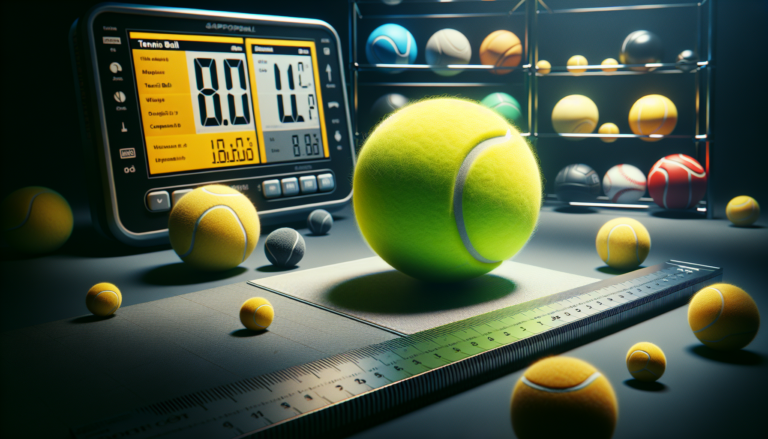Tennis is a beloved sport enjoyed by millions worldwide, and at the heart of the game lies the tennis ball. While seemingly simple, the size and specifications of a tennis ball play a crucial role in the sport’s dynamics and the overall playing experience. In this comprehensive guide, we’ll delve into the intricacies of tennis ball size, exploring the official dimensions, weight, and various types of tennis balls available. Whether you’re a seasoned player or a curious enthusiast, understanding the fundamentals of tennis ball size will enhance your appreciation for the sport.
The size of a tennis ball is not merely an arbitrary measurement; it directly impacts the ball’s performance on the court. The dimensions and weight of the ball influence factors such as bounce height, speed, and spin, which in turn affect the gameplay strategies employed by players. Consistency in tennis ball size is crucial for maintaining a level playing field in competitive matches, ensuring that all players have access to the same standard of equipment.
Introduction to Tennis Ball Size
Importance of Tennis Ball Size in the Game
The size of a tennis ball plays a pivotal role in the sport, as it directly affects the ball’s behavior during play. The dimensions and weight of the ball influence its bounce, speed, and spin, which are essential factors that players must navigate to excel on the court. A ball that is too small or too large can significantly alter the game’s dynamics, making it challenging for players to execute their shots accurately.
Moreover, consistency in tennis ball size is paramount for maintaining fairness in competitive matches. The International Tennis Federation (ITF) sets strict standards for tennis ball specifications to ensure that all players compete with the same quality of equipment. This standardization allows for a level playing field, enabling players to showcase their skills without any undue advantage or disadvantage arising from variations in ball size.
Official Tennis Ball Dimensions and Weight
Diameter of a Tennis Ball
According to the ITF’s official specifications, a tennis ball must have a diameter between 2.575 inches (6.541 cm) and 2.700 inches (6.858 cm). This relatively small range ensures that all tennis balls used in competitive play are of a consistent size. The diameter of the ball affects its aerodynamics and how it interacts with the tennis racket strings upon impact.
It’s important to note that even slight variations in diameter can have noticeable effects on the ball’s performance. A ball on the smaller end of the permitted range may travel faster through the air, while a larger ball might offer more spin potential. However, these differences are typically minimal and do not significantly alter the overall gameplay.
Weight of a Tennis Ball
In addition to the diameter, the weight of a tennis ball is also strictly regulated. The ITF mandates that a tennis ball must weigh between 1.975 ounces (56.0 grams) and 2.095 ounces (59.4 grams). This weight range ensures that the balls have sufficient mass to travel the required distance on the court while still being light enough for players to generate speed and spin.
The weight of the ball influences its momentum and how it responds to the force applied by the tennis racket. A slightly heavier ball may have more stability in windy conditions, while a lighter ball could offer more maneuverability. However, as with the diameter, the differences in weight within the approved range are minimal and do not substantially impact the game.
ITF Standards for Tennis Balls
To maintain consistency and fairness in tennis competitions, the ITF has established rigorous standards for tennis balls. These standards cover various aspects, including the ball’s size, weight, deformation, and bounce. Manufacturers must adhere to these specifications to produce balls that are suitable for use in official tournaments and matches.
The ITF conducts thorough testing to ensure that tennis balls meet their stipulated criteria. Balls are subjected to a series of tests that measure their diameter, weight, compression, and bounce under controlled conditions. Only balls that pass these stringent tests are approved for use in sanctioned events, guaranteeing that players have access to high-quality, standardized equipment.
In addition to the size and weight requirements, the ITF also specifies the acceptable range for ball deformation and bounce. Deformation refers to how much the ball compresses when struck, while bounce relates to how high the ball rebounds off the court surface. These factors contribute to the ball’s overall performance and feel during play.
By enforcing these standards, the ITF maintains the integrity of the sport and ensures that tennis balls used in competitions meet the highest quality benchmarks. This standardization allows players to focus on their skills and strategies, knowing that the equipment they are using is consistent and reliable.
Types of Tennis Balls
Competition Tennis Balls
Competition tennis balls, also known as championship or tournament balls, are the highest-grade balls designed for professional-level play. These balls undergo rigorous testing to ensure they meet the exacting standards set by the ITF. They are manufactured to provide optimal performance, durability, and consistency, making them the choice of tennis professionals and serious competitive players.
Competition balls are typically made with high-quality materials, such as premium rubber compounds and fine-grade felt. The construction of these balls is engineered to deliver excellent bounce, speed, and spin, enabling players to execute their shots with precision and control. The felt cover is also designed to withstand the rigors of intense play, maintaining its integrity and performance throughout long matches.
Practice Tennis Balls
Practice tennis balls, also referred to as recreational or training balls, are designed for everyday use and are suitable for players of all skill levels. These balls are more affordable and are often sold in bulk quantities, making them a cost-effective option for regular practice sessions and casual play.
While practice balls still adhere to the official size and weight specifications, they may have slightly different performance characteristics compared to competition balls. The materials used in their construction may be of a lower grade, resulting in a slightly softer feel and less durability. However, practice balls still provide a good playing experience and are ideal for honing skills, practicing drills, and enjoying friendly matches.
Mini Tennis Balls
Mini tennis balls, also known as foam balls or starter balls, are smaller and softer than standard tennis balls. They are designed specifically for children, beginners, and players who are new to the sport. These balls have a lower compression and travel slower through the air, making them easier to hit and control.
Mini tennis balls are typically made of foam or soft rubber, which reduces the impact on the racket and the player’s arm. They are often used in conjunction with smaller court sizes and lower net heights to create a more manageable playing environment for young players. As players progress and develop their skills, they can gradually transition to standard tennis balls.
Comparing Tennis Balls
Bounce Height and Performance
One of the key factors that differentiate tennis balls is their bounce height and overall performance. The bounce of a tennis ball refers to how high it rebounds after striking the court surface. A ball with a higher bounce will come off the court with more energy, making it easier for players to hit powerful shots. Conversely, a ball with a lower bounce will require more effort to generate pace and may suit players who prefer a more controlled playing style.
The bounce height of a tennis ball is influenced by several factors, including the ball’s internal pressure, the composition of the rubber core, and the texture of the felt cover. Balls with higher internal pressure tend to have a more lively bounce, while those with lower pressure may feel softer and offer more control. The rubber core’s density and resilience also contribute to the ball’s bounce characteristics.
Performance-oriented tennis balls, such as those used in professional tournaments, are engineered to provide an optimal balance of bounce, speed, and spin. They are designed to respond well to the powerful strokes of elite players while maintaining consistency and durability. Recreational players may prefer balls with slightly lower bounce or softer feel, as they can be more forgiving and easier to control.
When comparing tennis balls, it’s essential to consider your playing style, skill level, and personal preferences. Some players may prioritize a higher bounce for aggressive play, while others may favor a softer ball for improved feel and touch. Experimenting with different brands and models can help you find the tennis ball that best suits your game.
Color and Visibility
The color of a tennis ball is another aspect that can vary between different types and brands. While the traditional tennis ball color is white, the most common color used in modern tennis is fluorescent yellow, also known as optic yellow. This bright, vibrant hue was introduced to improve visibility for both players and spectators, especially during televised matches.
The fluorescent yellow color provides a stark contrast against the green or blue tennis court surface, making it easier for players to track the ball’s movement. This enhanced visibility allows players to react more quickly and accurately to incoming shots, improving the overall quality of play. The vivid color also makes it easier for spectators to follow the ball’s trajectory, enhancing their viewing experience.
While fluorescent yellow is the predominant color in tennis, some tournaments and events may use balls with different colors for specific purposes. For example, red or orange balls may be used in junior or beginner-level matches to provide a slower pace and lower bounce, making it easier for young players to develop their skills. In some cases, special edition balls with unique colors or designs may be used to commemorate significant events or anniversaries.
It’s worth noting that while the color of the tennis ball does not directly impact its performance, it can affect a player’s perception and reaction time. Some players may have a personal preference for a particular color or find certain hues more visually appealing. However, in terms of official regulations, the ITF does not specify a mandatory color for tennis balls, allowing manufacturers to choose from a range of approved colors.
Conclusion
Understanding the dimensions, weight, and various aspects of tennis ball size is essential for players, coaches, and enthusiasts alike. The official size and weight specifications set by the ITF ensure fairness and consistency in competitive play, allowing players to showcase their skills on a level playing field. Whether you prefer the high-performance characteristics of competition balls or the affordability and versatility of practice balls, choosing the right tennis ball can enhance your playing experience.
When selecting tennis balls, consider factors such as bounce height, color, and overall performance to find the best fit for your playing style and preferences. Experimenting with different types and brands can help you discover the ball that complements your game and elevates your performance on the court.
As you continue to explore the world of tennis, remember that the humble tennis ball plays a crucial role in the sport’s dynamics and enjoyment. By understanding the intricacies of tennis ball size and specifications, you’ll be well-equipped to make informed choices and fully appreciate the nuances of this beloved game.






